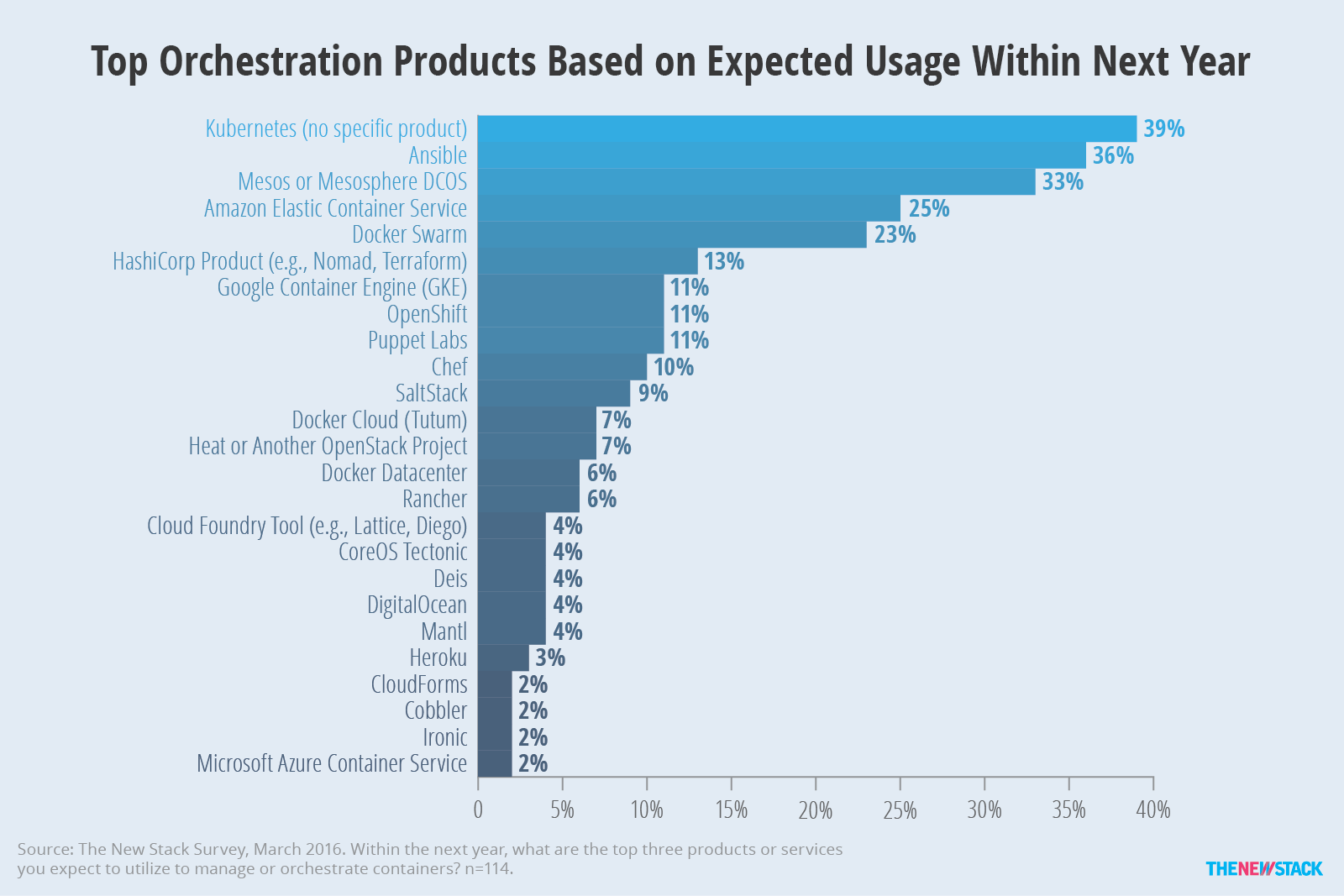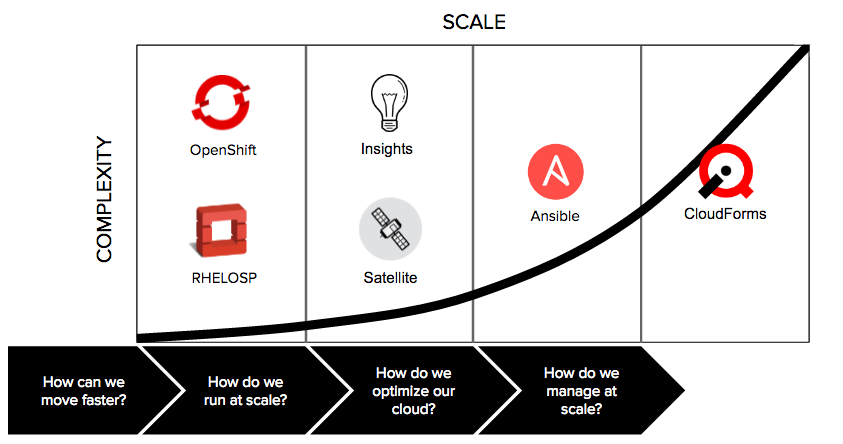By now, it’s hopefully clear that Red Hat is very serious about Management, with a continual commitment and a constant look at the big picture.
OUR COMMITMENT
Over the years, we expressed our commitment to become a key IT management player in a number of ways:
- Through M&A activities, with the acquisition of ManageIQ in 2012 and the acquisition of Ansible in 2015
- Through organic growth, with the launch of Satellite (originally known as Red Hat Network) in the early days and Insights in 2015
- Through cross-portfolio integration, by using CloudForms as the administrative backbone for OpenShift, our Platform-as-a-Service (PaaS) cloud engine, and by bundling CloudForms and Red Hat OpenStack Platform, our Infrastructure-as-a-Service (IaaS) cloud engine
This week we further express our commitment in additional ways:
- Through cross-product integration, by invoking, for example, Ansible automation engine to provision CloudForms catalog objects, and to automatically execute remediation plans generated by Insights.
We plan to further progress down this path by integrating Ansible with [Satellite][I think that we generally refer to this as Red Hat Satellite] as well.
- Through laser-focused support for specific use cases, like, for example, using Ansible to automate the provisioning of Linux containers from the development stage on developers’ machines all the way to the production stage on corporate datacenters.

We have grown and evolved our portfolio faithful to enable and support our customers in their march towards a Frictionless IT, shaping our offering after its core principles like ease of use. Three examples:
- Our newest offering, Insights, features a Software-as-a-Service delivery model to reduce at its minimum the cost of entry.
- Ansible, already considered one of the easiest product to use among IT automation and configuration management tools in the market, has grown in popularity as an easy way to manage containers.
- CloudForms ships as single virtual appliance where some competitors still want you to setup and configure 6-12 systems to deploy their cloud management platform.
But what is the big picture? Why these specific products? What is guiding our decisions in terms of management portfolio growth?
THE BIG PICTURE
Part of the answer to the above questions is in the cloud maturity model below, shaped after the dimensions of scale and complexity.

If your cloud project is successful, it will likely grow in scale as more and more Lines of Business trust your IT organization to host their applications. Not only guided by common sense, we saw the relationship between success and scale through first hand experience by working with many customers worldwide, and with further validation resulting from a highly detailed TCO analysis that we published recently.
Popularity has a side effect. As more LoBs approach the private or hybrid cloud you built, the business demand will also likely start to diversify and your IT organization may be requested to host not just a great variety of greenfield applications, but also brownfield ones that were not designed to run on IaaS and PaaS clouds. We saw this over and over in conversations with clients, and we heard it even more on stage of industry events like the OpenStack Summit from now very experienced early adopters.
This diversification increases the complexity of the cloud environment, both in terms of complexity of applications to deploy and manage, and in terms of integration with IT systems outside the cloud environment.
So the question is: “How do you manage that growing complexity as you evolve in your cloud journey?”

You begin the cloud journey by asking yourself, “Can we move faster?” The first step to answering that question consists of deploying a cloud engine. Your decision to adopt a IaaS or PaaS cloud engine depends on many factors, including cultural fit, readiness to standardize the computing stack at a certain level, preference to work with virtual machines or containers, and much more.
Your cloud engine of choice comes with its own set of management tools, which are perfectly fine to address the needs of an IT organization up to a certain level of complexity. After that level, which varies from organization to organization, your business likely will require more sophisticated support, just like a landlord that expands his/her real estate business, embracing services like Airbnb and beyond.
As you grow in scale, the first management solutions that you may want to consider are the ones that can preserve the health of your growing IT environment, enabling you to run at scale. For this stage of maturity, Red Hat offers Insights and Satellite. Insights can proactively identify configuration issues and security vulnerabilities before they become critical, generating an appropriate remediation plan. Satellite, conversely, can deploy trusted software content and security patches at scale, enabling IT Ops to fix whatever issue has been identified by Insights or by the IT organization manually.
As the complexity increases along the way, and your cloud environment is requested to serve and host increasingly diverse applications, you may want to consider an IT automation solution to help maximize the efficiency of your cloud. For this stage of maturity, Red Hat offers Ansible. Ansible is capable of automating the provisioning and configuration of the components of a multi-tier application, including the underlying resources that serve the application, like networking.
As both scale and complexity reach their peak, at the most advanced stage of maturity in your cloud journey, you may want to consider a cloud management platform to govern the private cloud environment side by side with public clouds and pre-existing server virtualization environments in a coherent way. For this stage of maturity, Red Hat offers CloudForms. CloudForms provides a single pane of glass to control, automate and keep compliant a truly hybrid IT environment composed of VMware, Microsoft, Amazon, Google, and Red Hat technologies.
In other words, we are investing in the Red Hat Management portfolio to support our customers at every stage of the maturity model described here, both when they follow the adoption path described so far and when they have more ad-hoc business needs to address (1).
There’s much more that we can do, and that we’ll do, to empower IT organizations in their digital transformation. So, as usual, stay tuned for more.
Alessandro Perilli
GM, Management Strategy
@giano
------------------
(1) - Do we expect all customers to follow the exact adoption path described in this blog post? No. In fact, multiple customers start adopting some of our management solutions much earlier in their cloud journey. Which is why we leverage CloudForms in both our IaaS and PaaS cloud engines, or why we launched the Ansible Container project, as a way to support IT organizations that want to work with containers from the earliest maturity stages.
Sobre el autor
Alessandro Perilli is the GM, Management Strategy at Red Hat.
Perilli helps to chart the long-term strategy in the Red Hat management business unit, including company efforts in cloud management, IT automation, and self-healing IT. He also develops the vision behind new management initiatives in multiple areas like cybersecurity and artificial intelligence. He has led the creation of Ansible Security Automation.
Perilli is a member of the European AI Alliance and has co-authored the first Cloud Computing Risk Assessment for the European Network and Information Security Agency (ENISA). He is a former Gartner analyst, where he led the research for private cloud and cloud management in the early years of cloud computing. He was also a pioneer of the virtualization industry as an advisor for Fortune Global 2000 companies.
Perilli started his career in 1999, publishing a book about cybersecurity for Arnoldo Mondadori Editore and creating one of the first ethical hacking classes in the world.
Navegar por canal
Automatización
Conozca lo último en la plataforma de automatización que abarca tecnología, equipos y entornos
Inteligencia artificial
Descubra las actualizaciones en las plataformas que permiten a los clientes ejecutar cargas de trabajo de inteligecia artificial en cualquier lugar
Servicios de nube
Conozca más sobre nuestra cartera de servicios gestionados en la nube
Seguridad
Vea las últimas novedades sobre cómo reducimos los riesgos en entornos y tecnologías
Edge computing
Conozca las actualizaciones en las plataformas que simplifican las operaciones en el edge
Infraestructura
Vea las últimas novedades sobre la plataforma Linux empresarial líder en el mundo
Aplicaciones
Conozca nuestras soluciones para abordar los desafíos más complejos de las aplicaciones
Programas originales
Vea historias divertidas de creadores y líderes en tecnología empresarial
Productos
- Red Hat Enterprise Linux
- Red Hat OpenShift
- Red Hat Ansible Automation Platform
- Servicios de nube
- Ver todos los productos
Herramientas
- Training y Certificación
- Mi cuenta
- Recursos para desarrolladores
- Soporte al cliente
- Calculador de valor Red Hat
- Red Hat Ecosystem Catalog
- Busque un partner
Realice pruebas, compras y ventas
Comunicarse
- Comuníquese con la oficina de ventas
- Comuníquese con el servicio al cliente
- Comuníquese con Red Hat Training
- Redes sociales
Acerca de Red Hat
Somos el proveedor líder a nivel mundial de soluciones empresariales de código abierto, incluyendo Linux, cloud, contenedores y Kubernetes. Ofrecemos soluciones reforzadas, las cuales permiten que las empresas trabajen en distintas plataformas y entornos con facilidad, desde el centro de datos principal hasta el extremo de la red.
Seleccionar idioma
Red Hat legal and privacy links
- Acerca de Red Hat
- Oportunidades de empleo
- Eventos
- Sedes
- Póngase en contacto con Red Hat
- Blog de Red Hat
- Diversidad, igualdad e inclusión
- Cool Stuff Store
- Red Hat Summit

